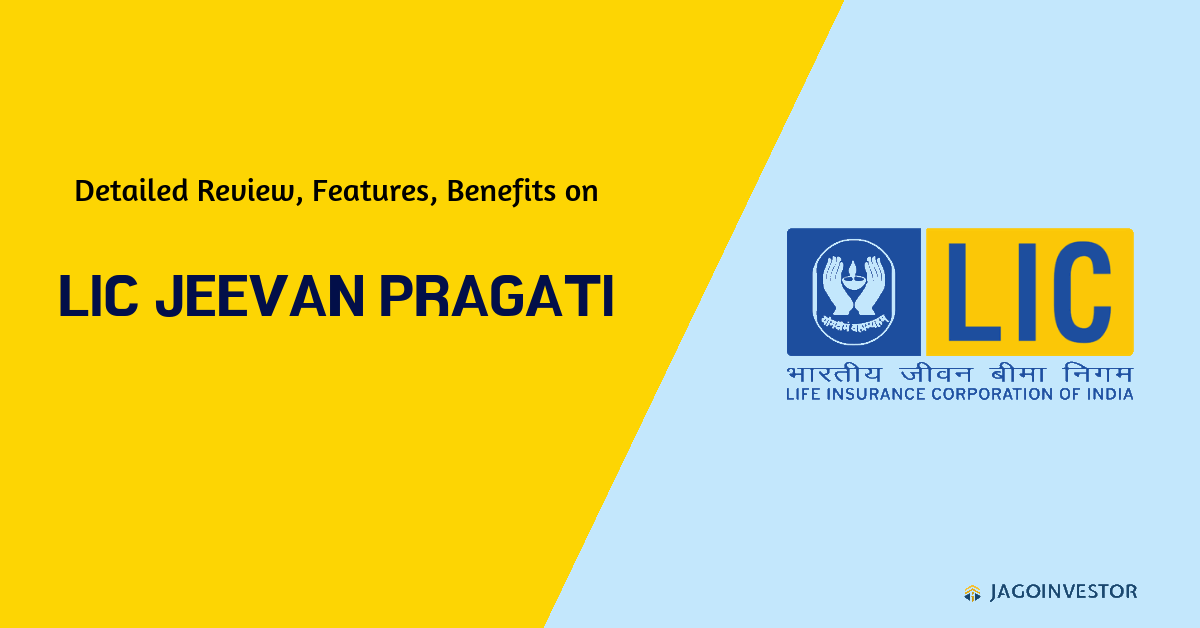LIC Jeevan Pragati (Table 838) – Review, Features and Benefits
LIC’s Jeevan Pragati is a non-linked endowment plan with a combination of financial protection and savings. In this policy, the sum assured on death increases every 5 years during the policy term. Savings from this policy can be used to fulfill long term goals.

Features of this Policy – (Table number 838)
- Maturity Amount is tax-free under section 10(10D).
- Tax benefit under 80C of income tax act for the premium paid.
- If the premiums have been paid for consecutive 3 years then the loan facility can be availed.
- One can get surrender value only after premium payment for 3 consecutive years.
- Minimum and Maximum sum assured is Rs 1.5 lacs and no limit.
- Free look for 15 days is available from the date of receipt of the policy bond.
- Maximum maturity age is 65 years.
Benefits of this policy –
- Death Benefit: In case of death during the policy term, provided all due premiums have been paid, Death benefit, defined as the sum of “Sum Assured on Death “, vested Simple Reversionary Bonuses and Final Additional bonus, if any, shall be payable. This death benefit shall not be less than 105% of all the premiums paid as on date of death.
- Maturity Benefit: If the policyholder survives till the end of the policy term on payment of all the premiums due then the policyholder will receive “Sum Assured on Maturity” ( Basic Sum Assured) + Vested Simple Reversionary bonuses + Final Additional bonus, if any, shall be payable in a lump sum.
- Rider Benefit: Rider Benefit in the form of LIC’s Accidental Death and Disability Benefit is available. If a policyholder wants this benefit then the policyholder will have to pay an extra premium for the benefit. Rider sum assured cannot exceed the Basic Sum Assured.
- Tax Benefit: Tax Benefit for the premiums paid u/s 80C and death/maturity benefit amount received paid u/s 10(10D) of Income Tax Act, 1961.
Eligibility criteria of this policy –
Below table depicts the eligibility criteria of the LIC’s Jeevan Pragati Policy –
| Minimum Entry Age – 12 yrs | Maximum Entry Age – 45 years |
| Maximum Maturity Age – 65 yrs | Minimum and Maximum Sum Assured are Rs. 1.5 Lakhs and No Limit |
How this policy works –
Let’s see an example –
Raj (30-year-old) buys the LIC’s Jeevan Pragati Plan for a basic sum assured of Rs.1.5 lakh with a policy term of 20 years. The premium which he will be paying will be around Rs. 7611. The LIC Jeevan Pragati plan can offer returns at 6% or 7%. On assuming the return of 6% to 7% annually the policyholder may get around Rs.3.3 lakh at the maturity of the policy.
Upon the death of the policyholder, his nominee will receive the Final Additional Bonus + simple reversionary bonuses + sum assured on death, provided all the premiums have been paid by the policyholder on time when he was alive.
*The above example is for illustrative purposes only. Customers should contact representatives of LIC for details and accurate calculations.
Exclusions of the Policy –
If the Policyholder commits suicide within 12 months from the start of the policy, then LIC will not be liable to pay the death benefit amount to the nominee of the policyholder.
Is there any rider benefit in the policy?
Yes, LIC’s Jeevan Pragati Plan offers the Disability Benefit and Accidental Death benefit as a rider. It is important to note that the rider sum assured should not exceed the basic sum assured. One can avail both the riders under this plan by paying an additional premium. The minimum age to avail the benefit of the rider is 18 years.
Can the policy be revived if lapsed?
Yes, the policy can be revived within 2 years since the last date of unpaid premium but before the maturity date of the policy.
Can I avail loan facility under this policy?
If the premiums have been paid for consecutive 3 years then the loan facility can be availed.
Can I get surrender value if my policy is just 1 year old?
No, one cannot get surrender value if the policy is just 1 year old. To achieve the surrender value, the policy needs to active for 3 years with fully paid premiums.
Video Review of the Policy –
Conclusion –
So, by now everyone of you have come to know each and every details of this policy. Now it’s up to you all to decide whether this policy will satisfy your requirements or not. If you have any doubt regarding this policy, they please let us know in the comment section.
